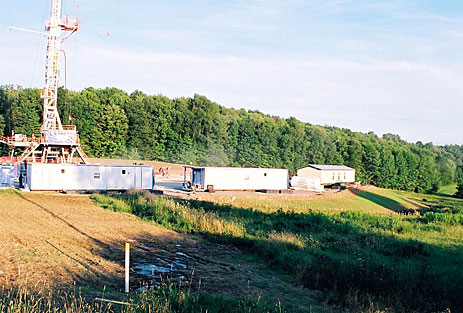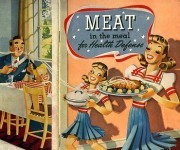A 1942 National Livestock and Meat Board ad.Image: Brian BennettCross-posted from Food Safety News.
In an email exchange with Richard Raymond over my recent article on the massive Cargill recall of salmonella-tainted ground turkey, the former head of food safety at USDA warned me that a likely result of tightened food safety laws would be “higher food prices, making meat and poultry unaffordable sources of protein to some.”
To which I replied: “I have no problem with that.”
This exchange, combined with the writing of a few colleagues lately on the alleged conundrum caused by expensive, ethically raised animals, made me realize that some good food advocates are making the wrong arguments.
For example, Jane Black, writing for The Atlantic, lamented last week about $8-a-dozen organic eggs at her local farmers market in New York City, while Mother Jones food blogger Tom Philpott (sympathetic to Black) cites research showing pigs could be raised sustainably and humanely for only slighty more than conventionally tortured ones, and if the bad guys internalized environmental costs, shoppers would pay less for the good meat than conventional. While this all may be quite interesting to foodies, for me it misses the bigger picture.
How we got into this mess
Once upon a time, eating meat was too expensive for mass consumption. Thus most people used it for flavoring or ate it on special occasions.
Enter industrial agriculture, combined with rapid consolidation spurred by intense competition (grow big or get out), propped up by massive government tax subsidies, making the inputs of animal agriculture cheaper than ever before (think feed made of corn and soy). Top it all off with government-sponsored “check-off” programs that require producers to participate in marketing and “educational” campaigns such as “Beef: It’s What’s for Dinner” and the inanely ubiquitous “Got Milk” ads, and the cheap meat-and-dairy-centered diet was guaranteed.
Only one small problem: Turns out this standard American diet of bacon and eggs for breakfast, followed by a cheeseburger for lunch and steak for dinner, has resulted in an epidemic of health problems like heart disease, diabetes, and cancer, just to name a few. While creating a national pastime of eating industrial animal products three times a day may have been a boon to Big Agribusiness (not to mention Big Pharma — how many people do you know over 60 who aren’t on cholesterol-lowering medication?), for the rest of us it’s a been a public health disaster. (A steady diet of junk food such as chips, cookies, and soda hasn’t helped either.)
That’s why for many years, every single health organization concerned with chronic disease agrees that Americans need to eat lower on the food chain, which means replacing foods such as meat, poultry, cheese, and eggs with whole grains and vegetables. Even the notoriously political federal Dietary Guidelines for Americans recommends eating mostly plant-based foods. The recently updated “MyPlate” icon demonstrates how three-quarters of the diet should come from grains, vegetables, and fruits. That’s how strong the science is on plant-based eating: even the USDA could no longer ignore it.
And yet when it comes to the world of organic and sustainable agriculture, I don’t hear much about this very mainstream public health message. Rather, I see a lot of hand-wringing and head-scratching over how we are going to replace conventionally raised cattle, pigs, and chickens with allegedly better ones. Let’s leave alone for now the ethical questions this approach raises; after all, the animals are still ultimately killed for our eating pleasure. (See James McWilliams’ scathing critique of “conscientious carnivores” in The Atlantic last month.)
Indeed, there are resources galore, including books, websites, and glossaries [PDF], plus the inevitable greenwashing, all educating consumers on how they can have their meat and eat it, too. (In contrast, a recently released meat guide from the Environmental Working Group does contain a clear “eat less” message.)
I’ve even heard of vegetarians taking up eating animals again because they can now purchase grass-fed beef or pasture-raised chickens, albeit at higher prices. But none of this makes sense to me. If the American diet became centered on animal products, thanks to subsidized industrial agriculture, combined with incessant marketing bordering on brainwashing (e.g., meat = protein), then why create and market a parallel diet based on sustainably raised animals? For example, if so many other cultures not only survive but thrive without eating dairy at all, is organic milk really something Americans absolutely must have?
How we need to get out of this mess
Thanks largely to our agricultural policies, the deck is stacked against producers who want to raise animals without confining them in horrible conditions or feeding them an unnatural diet. Combined with the reality that raising animals is a significantly more complex undertaking than, say, growing lettuce, it stands to reason that doing so will cost more. Thus, it seems obvious that, at least for the foreseeable future, most food resulting from such animals will come at higher prices, meaning that only a small segment of the population will be able to afford it, and many of these folks will likely be forced to eat less of it.
This is exactly what every health organization has been recommending for decades, and what even the USDA just admitted: Americans need to eat fewer animal products and more plant-based foods. Now, I can hear you ethical meat-eaters saying, “But wait, grass-fed beef is healthier!” Maybe, but let’s be honest: only marginally so. Plant-based protein sources such as grains and legumes are superior because they come with disease-preventing fiber and naturally contain a wide variety of vitamins and minerals that our bodies need to thrive. No amount of “healthy meat” can duplicate that, no matter what’s in the feed, which is usually supplemented with nutrients anyway.
Of course, there’s no guarantee that even if meat becomes too expensive, Americans will automatically switch over to fresh vegetables and whole grains, which remain hard to find in too many areas of the country. It’s entirely possible that people will just eat more Doritos and Chips Ahoy instead, which, sadly, are much more readily available.
That’s exactly why, instead of fretting over the high cost of organic eggs, we should focus on changing this bigger picture, which also involves many complex and challenging policy changes. Then maybe we would make some progress toward shifting the American diet to health-promoting, disease-preventing, plant-based foods. Just like things used to be.



